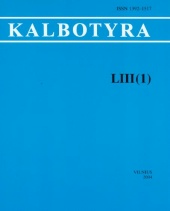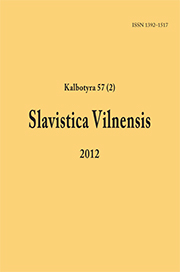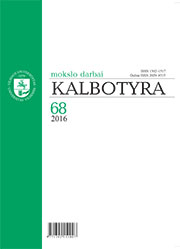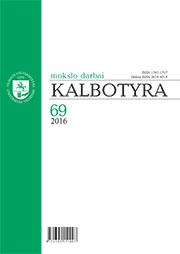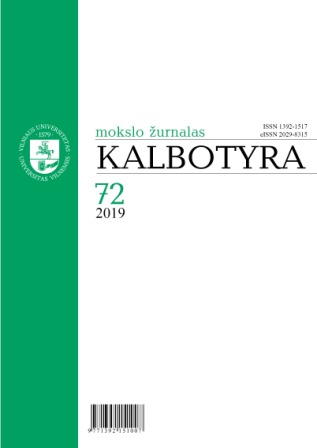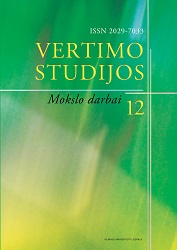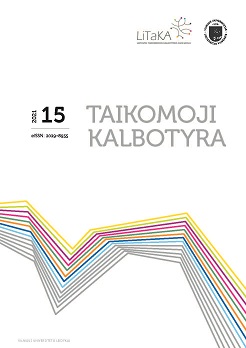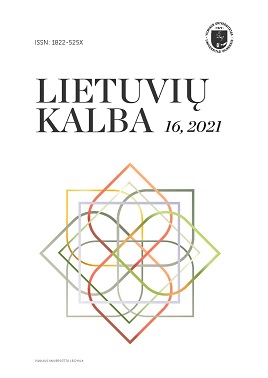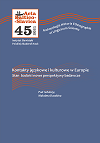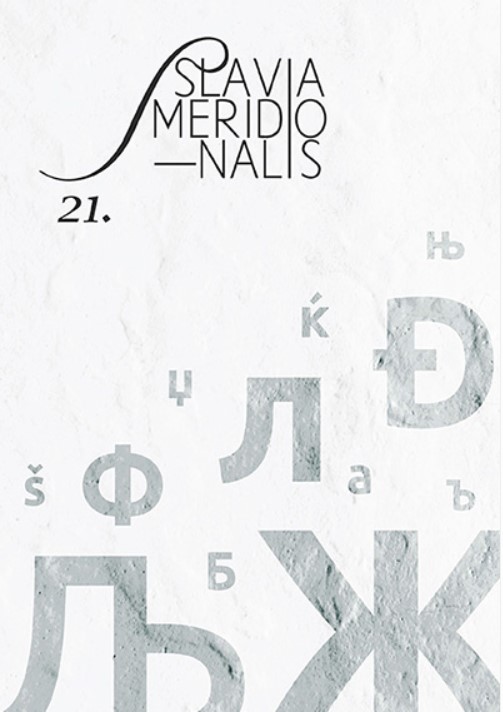Author(s): Rolandas Mikulskas / Language(s): Lithuanian
Issue: 16/2021
In an earlier publication (Mikulskas 2018), a contrastive study of the syntactic and semantic properties of the copular verbs virto ‘turned into’ (lit. ‘fell over’) vs. tapo ‘became’, based on an analysis of the data of the Corpus of Modern Lithuanian, was presented. In the present article the author continues his investigation into the domain of aspectual copulas of dynamic origin with a study of pasidarė ‘became’ (lit. ‘made oneself’) vs. tapo. The final goal of this research is to show that all three copular constructions (henceforth — CCs), featuring the copular verbs virto, pasidarė and tapo, are different instantiations of the more abstract ingressive-aspect-expressing construction. The contrast between the CC featuring virto and the CC featuring pasidarė is discussed only sporadically in the present study, as the first has much less in common with the latter than the latter has with the CC featuring tapo: the main difference consists in that the copula virto selects for involuntary subject referents while pasidarė selects for agentive and / or intentional subject referents, as does, in most cases, the copula tapo. The sample for quantitative analysis was compiled from three different registers of the Corpus of Modern Lithuanian — fiction, non-fiction and mass media — each consisting of 100 running lines featuring one (or more) CC with the preterital verb forms pasidarė and tapo. In sum, the sample consists of 300 running lines featuring CCs for each copular verb under discussion. In section 2, a quantitative analysis of the syntactic distribution of two copulas — pasidarė and tapo — each within its own sample of 300 running lines, is presented. It shows that pasidarė occurs in CCs of the ascriptive type 4 times more often than in those of the inclusive type. For comparison, tapo occurs in a similar sample 2,8 times less often in CCs of the ascriptive type than pasidarė, but it is used there 3 times more often in CCs of the inclusive type. Within its own sample, tapo occurs in CCs of the inclusive type 2,2 times more often than in those of the ascriptive type. The relatively higher frequency of ascriptive CCs with pasidarė in comparison with inclusive ones in the sample (and in usage generally) can be accounted for by the previously established fact (Mikulskas 2018) that the other ingressive copula — virto, which also designates an incrementally developing change event, can be complemented by predicative adjectives only to a limited extent, so that in these cases it is apparently substituted for by the copula pasidarė, especially in the contexts where the agentivity and / or intentionality of the subject referent is not emphasized. In section 3 of the article a thorough study is offered of the semantic distribution of the copulas pasidarė and tapo in their respective samples. The possible designations of CCs with these two verbs are determined by the aspectual properties of the latter, which have established themselves in accordance with their inherited semantics. The preterite pasidarė designates an incremental durative change event and has a profile of the accomplishment type. Thus, with pasidarė, not just the completive-transitional stage of the ingressive-change event is included in the focus of the CC, but also (at least) the progression stage leading up to it. The preterite tapo usually designates an instantaneous change event (which has practically no duration) and has the profile of an achievement predicate. A CC with tapo focuses on the completive-transitional stage of the ingresive-change event. Despite the different aspectual profiles of their verbs, the designational zones of CCs with pasidarė and tapo intersect to a much larger extent than those of CCs with pasidarė and those with virto, both of which are based on predicates of the accomplishment type. The reason for this is that both copulas — pasidarė and tapo — predominantly select for agentive and / or intentional subject referents. But here also lies the main difference in the semantics of these two copulas. While in the case of the copula tapo the agentivity and / or intentionality of the subject referent is mainly implied by the wider context or the relevant cognitive model of the profiled event (as this verb has almost lost its original meaning), in the case of the copula pasidarė an agentive and / or intentional subject referent is always presupposed from the semantics of the verb. This presupposition is a vestige of the original semantics (backward pull; Traugott 2008: 34) inherited by the copular verb from its source construction. In previous research (Mikulskas 2020) it has been suggested that CCs with darytis / pasidaryti are anticausative counterparts of the so-called resultative constructions of culminative causation (abbr. RCCC) with (pa)daryti: the former were derived from the latter by means of the reflexive morpheme -si-. In Old Lithuanian texts only sporadic cases of such anticausative derivation are attested. While one may reasonably assign to such anticausative constructions a middle-voice interpretation, they can hardly be classified as fully fledged CCs (of the aspectual type). In terms of meaning, the first attested anticausative constructions with darytis / pasidaryti have not advanced far beyond the properly reflexive stage (the subject acts on itself to produce a change). The subject referents in such constructions were still agentive, intentional individuals. Thus, the constructions could not yet designate situations where the undergoer of the change profiled was an inanimate entity. As the analysis of the Corpus data shows, the situation in Contemporary Lithuanian has radically changed in this respect: in the sample investigated 62 % of the subject referents of the CC featuring the copula pasidarė are inanimate entities or phenomena and 66 % subject referents of these constructions are inert entities (things) or passive individuals (the corresponding numbers for CCs featuring the copula tapo are 55,7 % and 56,7 % respectively). These numbers evidence the distance on the path of grammaticalization which the copula darytis / pasidaryti has covered from its first attestations in the Old Lithuanian texts. Importantly, the copula pasidarė presupposes a kind of intentionality of its subject referents or, at least, their responsibility for the result of the change they have undergone, even if they are inanimate, inert objects or phenomena. In this case, the subject referents of the copula pasidarė are conceptualized by the speaker (/ hearer) as if they were intentional and / or responsible entities mainly through the cognitive mechanism of subjectification (Langacker 2002, 315−342; Langacker 2006). And this fact can be singled out as the main semantic difference setting the copula pasidarė apart from tapo. On the pragmatic level this semantic difference boils into two distinct communicative perspectives — inner vs. outer respectively, as it is formulated in the article. The pragmatic effect of inner communicative perspective, in the case of the CC featuring pasidarė, arises when the speaker (/ hearer) identifies herself with the presupposed intentional and / or responsible subject referent incrementally undergoing a change. The pragmatic effect of outer communicative perspective, in the case of the CC featuring tapo, arises when the speaker (/ hearer), from a neutral vantage point, just states the result of the ingressive change which the subject referent has undergone. In section 4, the interchangeability of the two copulas under discussion (pasidarė > tapo and tapo > pasidarė) is investigated. In evaluating whether the copulas pasidarė and tapo are interchangeable in a given CC, the criterion of semantic equivalence was used. Mostly these copulas are interchangeable in contexts where the communicative perspective is not sharply pronounced. Possible pasidarė > tapo cases are more easily found in those CCs that have inanimate, inert objects or phenomena as their subject referents, and possible tapo > pasidarė cases are more easily found in those CCs that have animate intentional individuals as their subject referents. The quantitative analysis of the sample shows that in about 14,3 % of the CCs contained in it the preterite verbal forms pasidarė and tapo can be used interchangeably. This fact allows the author to treat the constructions featuring these copulas as two different instantiations of a single CC expressing the ingressive aspect of the profiled change event. Taking into consideration the third preterital verb form with the same aspectual function — the copula virto, which can be used interchangeably with the copula tapo in about 13 % of the CCs previously (Mikulskas 2018) analysed in a comparable Corpus sample, the author suggests that CCs with the verb forms virto, pasidarė and tapo are three different instantiations of the more abstract ingressive-aspect-expressing construction.
More...
